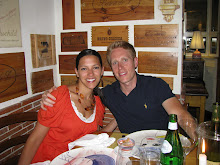The question has been raised and lowered by many as to why we continue to produce and eat salted cod when there is no longer the need for it. I guess part of it is tradition, and part of it is that salted and air-dried cod have different flavors and textures than fresh cod. No matter how much soaking and delicate cooking you do, preserved cod never quite gets back to its original form. Maybe that distinction is reason enough to continue the process.
I didn't grow up with the tradition of eating strictly seafood on Christmas Eve...sometimes I wish I had but now I get to celebrate that way with Nicole's family. I particularly look forward to cold Baccalá Salad, tossed in a lemony vinaigrette with crunchy vegetables and olives. It wouldn't be the same with fresh fish, which would likely fall apart and turn to mush, whereas baccalá maintains its firmness. So there you go.
The feast, although very prominent among the most traditional of Italian-American families, is not necessarily celebrated throughout Italy. It's more of a southern thing, which makes sense since most of us here trace our routes back to Il Mezzogiorno.
 The dish featured here is Baccalá alla Napoletana, or in the style of Naples. I've only made it with salted cod a couple of times, more often than not going for fresh cod since I can. This isn't necessarily a must-have at Christmas, but it would certainly not be out of place at such a feast.
The dish featured here is Baccalá alla Napoletana, or in the style of Naples. I've only made it with salted cod a couple of times, more often than not going for fresh cod since I can. This isn't necessarily a must-have at Christmas, but it would certainly not be out of place at such a feast. Bell peppers, roasted, with onions, tomatoes and capers make for a familiar flavor profile throughout the southern parts. As does fish lightly coated in flour and fried.
This recipe is similar to others from Tuscany south that serve the fish in some variation of tomato sauce, but here the roasted peppers stand out, their smokiness and syrupy sweetness defining the dish.
I've been using chickpea flour rather than wheat for a long time because it's healthier and imparts a bit of earthiness to the fish, along with extra goldiness. Either way, the light coating of just flour makes for just a thin crust, not too crunchy but enough to add some additional texture to the outside of the fish.
The flavors are clean with little to no saturated fat. Light enough for Summer, yet warming enough for any time of year, including the holidays.
Serves 6
6 sweet red, orange or yellow bell peppers
3 medium onions, sliced
1 32 oz. can San Marzano Tomatoes
2 Tablespoons capers
Extra Virgin Olive Oil
3 lbs. fresh cod or salt cod, cut into individual portions
1 1/2 cups all purpose or chickpea flour
Vegetable Oil for frying
Salt & Pepper to taste
Optional: fresh Flat Leaf Parsley to garnish
If using salt cod, place it in a large container with cold water and soak it for 2 to 3 days, changing the water twice daily. Drain and dry. Carefully remove any bones or skin.
Roast the peppers on the grill until charred on all sides. Place in a bowl and cover with plastic wrap for 15 minutes. When cool enough to handle, peel off all the skin and remove the seeds, preserving as much liquid as possible. Take the flesh and cut into strips.
In a large frying or saute pan heat a couple tablespoons of olive oil over medium heat. When it's shimmering add the onions and toss to coat with the oil. Turn the heat down to medium low and let the onions cook slowly, covered if need be so they get nice and brown without the edges burning too much first.
 Separate the tomatoes from their juices and cut them into strips. When the onions are nicely browned and soft, add the peppers and their juices, the tomatoes and their juices, and the capers. Let the sauce cook for 10 to 20 minutes at a low boil to meld the flavors. Season to taste with salt and pepper and leave simmering while you fry the fish.
Separate the tomatoes from their juices and cut them into strips. When the onions are nicely browned and soft, add the peppers and their juices, the tomatoes and their juices, and the capers. Let the sauce cook for 10 to 20 minutes at a low boil to meld the flavors. Season to taste with salt and pepper and leave simmering while you fry the fish. In a heavy pot add the vegetable oil to a depth of 1 1/2 to 2 inches and bring it to medium heat, or 375 degrees. Get a sheet pan ready with absorbent paper to drain the fish.
Place the flour in a shallow dish big enough to dredge the fish fillets. Salt and pepper the fish pieces, then dip them in the flour, turning to coat all over. Shake off the excess flour and put them on a baking sheet. You will probably need to fry in a couple to a few batches, so before each batch dredge the fillets once more just before going into the oil. Fry for 4 minutes, then flip and fry another 4 minutes until they're golden brown, maintaining the heat of the oil at medium. When they are finished frying, remove them to the pan with absorbent paper and season with a little more salt.
Once they're finished, place the fried fish in the pan of sauce and cook at a simmer for 5 to 10 minutes on top, then garnish with parsley and serve hot.




















